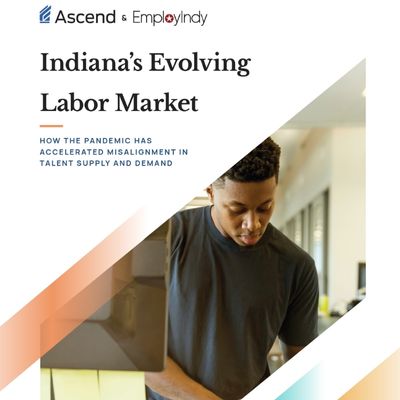 INDIANAPOLIS (Nov. 3, 2022) – A new report from Ascend Indiana and EmployIndy shows that as the COVID-19 pandemic restrictions began to ease over time, a vast and permanent shift emerged showing that highly skilled, highly educated workers were the most in-demand, while at the same time, Indiana was seeing significant declines in postsecondary enrollment by Indiana residents. In addition, the report shows that equity gaps in postsecondary education are reflecting those found in the workforce.
INDIANAPOLIS (Nov. 3, 2022) – A new report from Ascend Indiana and EmployIndy shows that as the COVID-19 pandemic restrictions began to ease over time, a vast and permanent shift emerged showing that highly skilled, highly educated workers were the most in-demand, while at the same time, Indiana was seeing significant declines in postsecondary enrollment by Indiana residents. In addition, the report shows that equity gaps in postsecondary education are reflecting those found in the workforce.
“As the labor market continues to change at a rapid pace, it is more important than ever for Indiana to produce and retain more college graduates with relevant and marketable knowledge, skills and abilities in order to obtain high-demand jobs being offered in growing numbers by employers,” said Jason Kloth, president and CEO of Ascend Indiana. “It is even more evident that additional steps need to be taken to assist Black and Hispanic/Latino students, who experienced the sharpest 2020 postsecondary enrollment declines during the pandemic, a trend that jeopardizes economic well-being for all.”
The report, Indiana’s Evolving Labor Market: How the Pandemic has Accelerated Misalignment in Talent Supply and Demand, was produced by Ascend Indiana, the talent and workforce development initiative of the Central Indiana Corporate Partnership (CICP), and EmployIndy, the workforce development board for Marion County. The report is intended to capture major changes in the supply and demand for talent in Indiana and in Central Indiana (Indianapolis-Carmel-Anderson MSA).
This report highlights the increasing importance of long-standing macroeconomic trends related to globalization, automation, and digitization and their impact on Indiana’s labor market. Many of these trends existed long before the pandemic began, but the events of the last two-and-a-half years have escalated the misalignment in the Indiana labor market.
Several key findings of labor market misalignment were found in the analysis with the following being the most prominent:
- The COVID-19 pandemic rapidly accelerated demand for degreed talent and slowed demand for non-degreed talent.
- From 2011 to 2019, most new jobs in Indiana required a high school diploma or no formal education credential. Due to the disproportionate impact of the pandemic, prior year gains in these jobs were erased. Postsecondary-level jobs, that were minimally impacted in 2020 during the pandemic, now account for a larger share of job growth.
- Too few high school students are pursuing postsecondary education, persisting, and graduating with a degree.
- Postsecondary enrollment rates once stood at 65% of Indiana high school graduates, but declined to 59% in 2019, and hit a new low in 2020 of 53%.
- Equity gaps in postsecondary education reflect those found in the workforce.
- Postsecondary outcomes diverge significantly by race/ethnicity and gender. These disparities carry over into workforce outcomes where people of color are underrepresented in high paying, fast growing careers that drive Indiana’s economy.
- In Marion County, post-pandemic demand has shifted significantly toward workers with postsecondary education and degrees.
- Post-pandemic job projections for Marion County indicate continued growth in jobs requiring a bachelor’s or higher degree levels, but a notable decline in jobs requiring a high school diploma or no formal education credential. The misalignment between job growth and educational attainment in Marion County will likely present significant short- and long-term challenges associated with deepening poverty levels.
“Increasing education and employer partnerships is foundational in changing some of these trends, with employers of all sizes providing career awareness and work-based learning experiences beginning in middle school and extending beyond high school,” said Marie Mackintosh, president and CEO, EmployIndy. “Engaging students and offering quality work-based learning opportunities including in-class and real-world experiences, has shown to be successful in supporting career readiness and workforce alignment, but more needs to be done to adopt data-driven strategies to expand on these learnings.”
Several opportunities outlined below are intended as recommendations that address alignment gaps and provide equitable opportunities to obtain quality jobs. Additional key recommendations can be found in the full report.
- Education and employer partnerships: These are foundational to initial development and successful implementation of aligned learning systems. As co-creators of talent, employers can and should actively engage in education processes to train their employees of tomorrow, including curriculum development, instruction, and experience delivery. Employer engagement with education systems must improve to meet accelerating and changing labor market conditions. Employers of all sizes should provide career awareness and exposure experiences beginning in middle and extending beyond high school.
- 21st Century Scholars automatic enrollment: Indiana’s 21st Century Scholars program provides income-eligible students up to full tuition and enumerated fees at Indiana postsecondary institutions. The current policy requiring sign up before the end of 8th grade contributes to under half of eligible students enrolling in the program. Students who meet 21st Century Scholar income and academic performance requirements should have access to scholarship funds and program benefits. A policy of automatic student enrollment would encourage more high school students to pursue college and help address Indiana’s declining postsecondary enrollment trends.
- Certificate research and analysis: A comprehensive study and evaluation of certificates programs and training providers is needed to understand Indiana’s certificate landscape. The state’s certificate landscape is rapidly expanding and changing, with significant activity not captured in established reporting processes. An analysis of this kind should capture these changes and critically evaluate industry value, stack-ability, job placement and wage growth.
The report also shows that a majority of Indiana’s leading industries including Healthcare, Transportation/Warehousing and Accommodation/Food Services have rebounded from the pandemic and are expected to continue to add more jobs through 2028. The sectors showing the most job posting levels through 2020 and 2021 are Professional/Scientific/Technical Services and Ambulatory Healthcare Services, which stand out for both high wages and high growth projections.
The Executive Summary and the Full Report, with additional recommendations, can also be found on the Ascend Indiana website at ascendindiana.com.
About Ascend Indiana
An initiative of the Central Indiana Corporate Partnership (CICP), Ascend Indiana is committed to making Indiana a place of economic opportunity for all. Ascend connects job seekers to good and promising career opportunities through an innovative job matching platform, the Ascend Network; catalyzes partnerships and provides consulting services to meet high-demand workforce needs through Ascend Services; and conducts research through Ascend Insights to enable systems-level change that positively impacts individuals throughout the state. To learn more, visit ascendindiana.com.
About EmployIndy
EmployIndy guides the local workforce ecosystem and makes strategic investments to remove barriers to quality employment for underserved and underrepresented residents. Our vision is for all Marion County residents to have access to services and training necessary to secure a livable wage and grow in a career that meets employer demand for talent. As the workforce development board for Marion County, guided by 26 business, civic, education and nonprofit community leaders, EmployIndy invests over $20 million in public, private and philanthropic funds for both youth and adults annually. Learn more at employindy.org.
